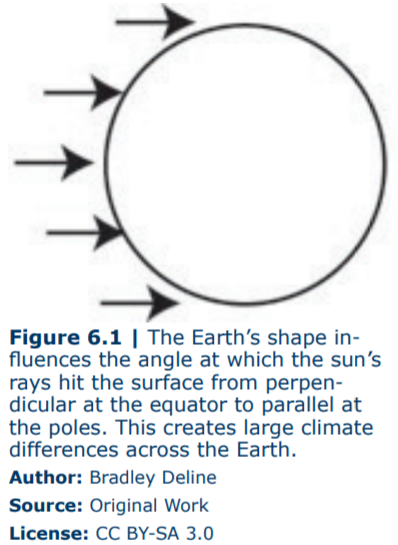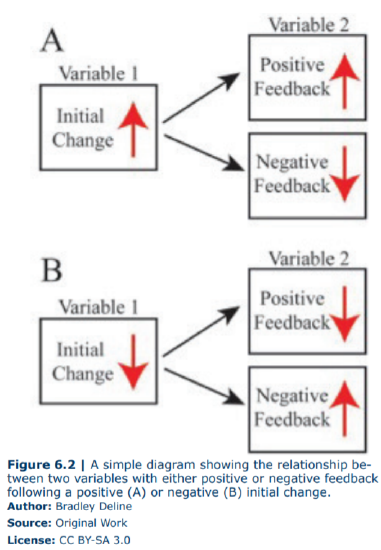6.2: The Climate System
- Page ID
- 5558
\( \newcommand{\vecs}[1]{\overset { \scriptstyle \rightharpoonup} {\mathbf{#1}} } \)
\( \newcommand{\vecd}[1]{\overset{-\!-\!\rightharpoonup}{\vphantom{a}\smash {#1}}} \)
\( \newcommand{\id}{\mathrm{id}}\) \( \newcommand{\Span}{\mathrm{span}}\)
( \newcommand{\kernel}{\mathrm{null}\,}\) \( \newcommand{\range}{\mathrm{range}\,}\)
\( \newcommand{\RealPart}{\mathrm{Re}}\) \( \newcommand{\ImaginaryPart}{\mathrm{Im}}\)
\( \newcommand{\Argument}{\mathrm{Arg}}\) \( \newcommand{\norm}[1]{\| #1 \|}\)
\( \newcommand{\inner}[2]{\langle #1, #2 \rangle}\)
\( \newcommand{\Span}{\mathrm{span}}\)
\( \newcommand{\id}{\mathrm{id}}\)
\( \newcommand{\Span}{\mathrm{span}}\)
\( \newcommand{\kernel}{\mathrm{null}\,}\)
\( \newcommand{\range}{\mathrm{range}\,}\)
\( \newcommand{\RealPart}{\mathrm{Re}}\)
\( \newcommand{\ImaginaryPart}{\mathrm{Im}}\)
\( \newcommand{\Argument}{\mathrm{Arg}}\)
\( \newcommand{\norm}[1]{\| #1 \|}\)
\( \newcommand{\inner}[2]{\langle #1, #2 \rangle}\)
\( \newcommand{\Span}{\mathrm{span}}\) \( \newcommand{\AA}{\unicode[.8,0]{x212B}}\)
\( \newcommand{\vectorA}[1]{\vec{#1}} % arrow\)
\( \newcommand{\vectorAt}[1]{\vec{\text{#1}}} % arrow\)
\( \newcommand{\vectorB}[1]{\overset { \scriptstyle \rightharpoonup} {\mathbf{#1}} } \)
\( \newcommand{\vectorC}[1]{\textbf{#1}} \)
\( \newcommand{\vectorD}[1]{\overrightarrow{#1}} \)
\( \newcommand{\vectorDt}[1]{\overrightarrow{\text{#1}}} \)
\( \newcommand{\vectE}[1]{\overset{-\!-\!\rightharpoonup}{\vphantom{a}\smash{\mathbf {#1}}}} \)
\( \newcommand{\vecs}[1]{\overset { \scriptstyle \rightharpoonup} {\mathbf{#1}} } \)
\( \newcommand{\vecd}[1]{\overset{-\!-\!\rightharpoonup}{\vphantom{a}\smash {#1}}} \)
\(\newcommand{\avec}{\mathbf a}\) \(\newcommand{\bvec}{\mathbf b}\) \(\newcommand{\cvec}{\mathbf c}\) \(\newcommand{\dvec}{\mathbf d}\) \(\newcommand{\dtil}{\widetilde{\mathbf d}}\) \(\newcommand{\evec}{\mathbf e}\) \(\newcommand{\fvec}{\mathbf f}\) \(\newcommand{\nvec}{\mathbf n}\) \(\newcommand{\pvec}{\mathbf p}\) \(\newcommand{\qvec}{\mathbf q}\) \(\newcommand{\svec}{\mathbf s}\) \(\newcommand{\tvec}{\mathbf t}\) \(\newcommand{\uvec}{\mathbf u}\) \(\newcommand{\vvec}{\mathbf v}\) \(\newcommand{\wvec}{\mathbf w}\) \(\newcommand{\xvec}{\mathbf x}\) \(\newcommand{\yvec}{\mathbf y}\) \(\newcommand{\zvec}{\mathbf z}\) \(\newcommand{\rvec}{\mathbf r}\) \(\newcommand{\mvec}{\mathbf m}\) \(\newcommand{\zerovec}{\mathbf 0}\) \(\newcommand{\onevec}{\mathbf 1}\) \(\newcommand{\real}{\mathbb R}\) \(\newcommand{\twovec}[2]{\left[\begin{array}{r}#1 \\ #2 \end{array}\right]}\) \(\newcommand{\ctwovec}[2]{\left[\begin{array}{c}#1 \\ #2 \end{array}\right]}\) \(\newcommand{\threevec}[3]{\left[\begin{array}{r}#1 \\ #2 \\ #3 \end{array}\right]}\) \(\newcommand{\cthreevec}[3]{\left[\begin{array}{c}#1 \\ #2 \\ #3 \end{array}\right]}\) \(\newcommand{\fourvec}[4]{\left[\begin{array}{r}#1 \\ #2 \\ #3 \\ #4 \end{array}\right]}\) \(\newcommand{\cfourvec}[4]{\left[\begin{array}{c}#1 \\ #2 \\ #3 \\ #4 \end{array}\right]}\) \(\newcommand{\fivevec}[5]{\left[\begin{array}{r}#1 \\ #2 \\ #3 \\ #4 \\ #5 \\ \end{array}\right]}\) \(\newcommand{\cfivevec}[5]{\left[\begin{array}{c}#1 \\ #2 \\ #3 \\ #4 \\ #5 \\ \end{array}\right]}\) \(\newcommand{\mattwo}[4]{\left[\begin{array}{rr}#1 \amp #2 \\ #3 \amp #4 \\ \end{array}\right]}\) \(\newcommand{\laspan}[1]{\text{Span}\{#1\}}\) \(\newcommand{\bcal}{\cal B}\) \(\newcommand{\ccal}{\cal C}\) \(\newcommand{\scal}{\cal S}\) \(\newcommand{\wcal}{\cal W}\) \(\newcommand{\ecal}{\cal E}\) \(\newcommand{\coords}[2]{\left\{#1\right\}_{#2}}\) \(\newcommand{\gray}[1]{\color{gray}{#1}}\) \(\newcommand{\lgray}[1]{\color{lightgray}{#1}}\) \(\newcommand{\rank}{\operatorname{rank}}\) \(\newcommand{\row}{\text{Row}}\) \(\newcommand{\col}{\text{Col}}\) \(\renewcommand{\row}{\text{Row}}\) \(\newcommand{\nul}{\text{Nul}}\) \(\newcommand{\var}{\text{Var}}\) \(\newcommand{\corr}{\text{corr}}\) \(\newcommand{\len}[1]{\left|#1\right|}\) \(\newcommand{\bbar}{\overline{\bvec}}\) \(\newcommand{\bhat}{\widehat{\bvec}}\) \(\newcommand{\bperp}{\bvec^\perp}\) \(\newcommand{\xhat}{\widehat{\xvec}}\) \(\newcommand{\vhat}{\widehat{\vvec}}\) \(\newcommand{\uhat}{\widehat{\uvec}}\) \(\newcommand{\what}{\widehat{\wvec}}\) \(\newcommand{\Sighat}{\widehat{\Sigma}}\) \(\newcommand{\lt}{<}\) \(\newcommand{\gt}{>}\) \(\newcommand{\amp}{&}\) \(\definecolor{fillinmathshade}{gray}{0.9}\)Overview
As was previously mentioned, climate is the long-term weather pattern across a region. It is important to emphasize the long-term portion of the definition to establish that climate is different from weather. Weather is the local and short-term patterns in temperature, humidity, precipitation, atmospheric pressure, wind, and other meteorological variables. As you well know, weather fluctuates throughout the day, week, month, and year such that it is difficult to see any trends beyond the random noise in the system. If you take a long-term view of weather we can begin to see patterns across time and geography that help to better understand and identify the factors that influence the climate system. The climate system is the interconnected network of variables that influence the earth’s climate, which includes components from the lithosphere, atmosphere, hydrosphere, cryosphere, biosphere, anthroposphere, and solar system.

The heat that feeds this system comes from two primary sources. First, there is heat radiating from the Earth itself, which is coming from the decay of radioactive material and residual heat from the formation of the earth. This heat is not distributed equally, with more heat escaping in areas where the crust is thinner, such as divergent boundaries. More significantly, the earth receives heat from solar radiation. Again, this heat is not distributed equally across the earth’s surface and the amount of energy received is related to the angle at which the solar radiation hits the surface of the earth (Figure 6.1). If the solar radiation hits perpendicular to the surface more heat is absorbed than if it hits at an oblique angle, which is why the tropics are warmer than the poles.
The material on the Earth’s surface is also important in that materials react differently to solar radiation. Some materials, normally dark in color, absorb and reradiate heat, most of which is retained at the surface of the planet. You are likely familiar with this if you have ever walked barefoot on dark concrete or asphalt in the summer. Other materials, that are shiny or light in color, reflect the solar radiation off the Earth’s surface. Materials such as snow or ice are particularly effective at reflecting solar radiation. This is the reason Arctic explorers must use eye protection to avoid snow blindness. The proportion of solar radiation that is reflected off the Earth’s surface is called albedo, which can vary depending on the type of ground cover. For instance, the Earth’s albedo is higher when it is covered with large expanses of glacial ice and thus the amount of sunlight absorbed and the temperature measured is lower.
Once the heat is reradiated off of the Earth’s surface it travels up into the atmosphere. Certain gases in Earth’s atmosphere, called greenhouse gases, allow sunlight to pass but absorb terrestrial energy and radiate it in all directions including back to the surface of the Earth. These gases, such as water vapor, carbon dioxide, and methane represent a tiny, though important fraction of the material in the atmosphere. Different greenhouse gases vary both in how effectively they absorb and reradiate energy and their relative proportions in the atmosphere, such that a higher concentration of potent greenhouse gases can retain more thermal energy within the atmosphere. The rest of the reflected and radiated energy escapes from the atmosphere and dissipates into space.
Several factors can influence the simplified version of the climate system described above. The amount of radiation produced from the sun varies over time. In addition, the shape of our orbit around the sun varies over time from more circular to more elliptical because of the gravitational influences from other planets in our solar system. The angle at which solar radiation hits the planets’ surface is influenced by the tilt and wobble of the Earth’s axis. The distribution of water, ice, snow, vegetation, and other materials on the Earth’s surface control the Earth’s albedo and can change over time. The proportion of greenhouse gases can change dramatically depending on the rate of plate motion as well as the amount of volcanism, photosynthesis, weathering of rocks, burning of fossil fuels, and many other factors (to examine trends on climate and carbon dioxide levels see Figure 6.5 later in the lab).
The efficiency of the transportation of heat across the surface of the Earth also influences climate. Heat is transferred across the surface of the planet by wind, ocean currents, and storms. Therefore, the position of the continents as well as air and ocean currents affect climate and can change over time. The components in our atmosphere are also important, including water vapor and aerosols (dust). Water vapor in the atmosphere is a greenhouse gas, can reflect incoming solar radiation, and is the source of precipitation. Aerosols can come from the Earth’s surface, ash from volcanoes, and the burning of fossil fuels and can alter climate by reflecting incoming solar radiation before it reaches the Earth’s surface. There are numerous additional factors that also have some level of effect on the climate system.

At this point, you should be able to recognize the complexity of the climate system based on the number of variables and how those variables can change over time. It is also important to recognize that all of these variables are connected. For instance, if a volcano erupts it adds some thermal energy to the climate system; it produces aerosols that block solar radiation from hitting the Earth’s surface and produces greenhouse gases that retain heat. Notice that these factors do not influence the climate in a consistent way. The change of one variable as the result of another is called feedback, which can be either positive or negative (Figure 6.2).
Positive feedback reinforces the initial change no matter the direction of that change. For instance, if the Earth warms, ice melts and reduces the albedo, which causes even more warming. This can also occur in the opposite direction. If the Earth cools, ice forms and increase the albedo, which causes more cooling. Negative feedback counteracts the initial change no matter the direction of the initial change. For instance, if the Earth warms, more area becomes arid resulting in an increase in the amount of dust in the atmosphere, which reflects solar radiation causing cooling. Again the opposite works, if the Earth cools, less area is arid, resulting in a decrease in the amount of dust in the atmosphere, which causes warming. Therefore, an understanding of the climate system requires identification of all of the important climate variables, how they are related to each other, the speed at which they can change, and the magnitude and direction of change of each feedback loop. The ideal way to gain a better understanding of the climate system is to study it through geologic history


